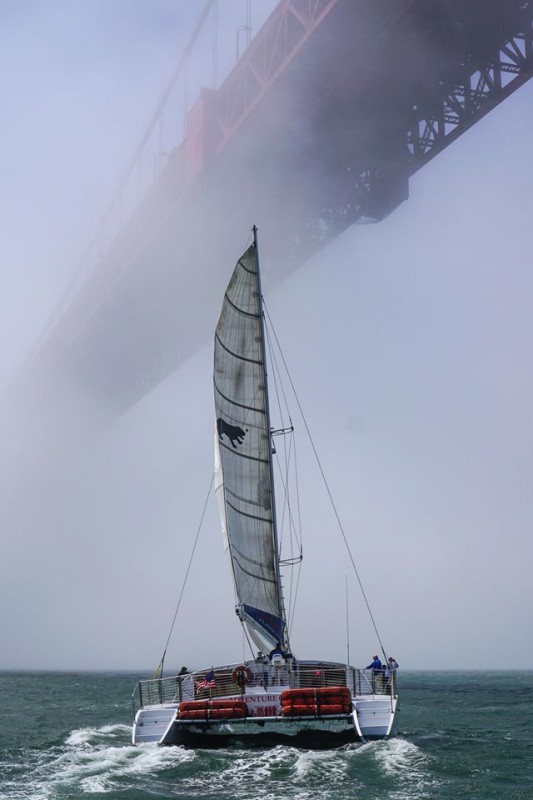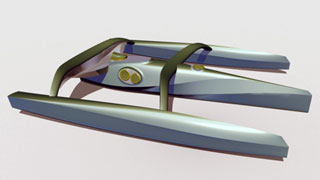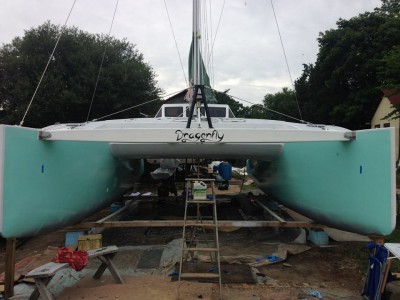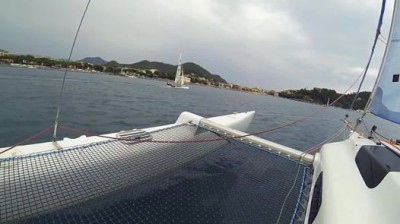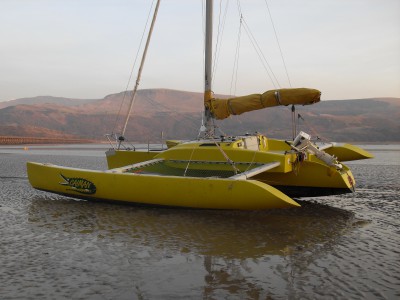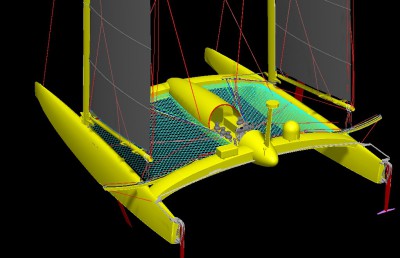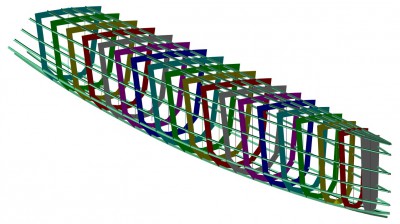Another nice view of the 65′ Adventure Cat 2 sailing under Golden Gate Bridge.
All posts by kurt
Rotating Mast Hounds
Rotating Mast Hounds-An Evolution
“we agree that every rotating mast has a single axis of rotation yes?”
For me the conceptual lodestar of rotating masts has been to imagine the wire from the shrouds and forestay morphing into strands at the mast that then spread out onto the mast.
When multis started using tripod rigs and rotating masts it profoundly improved performance and ease of sail handling. Mega roachy mains were now possible without some of the crazy workarounds that we saw in the 80s such as dropping the main down for every tack or jibe, or massive double running backstays and type A runner apes.
The earliest rotating hounds that I know of were Gougeon designs. They consisted of a chunk of aluminum, a beak, bolted inside of the mast. They were fixed. I used this system in my extrusion mast on my 31’ tri Smoholla and it worked very well. I could get 110 degrees of rotation each side of centerline. The rotation was provided by a toggle between the rig plate and the beak, and another at the wire terminal. Rotation was allowed by the slop between these.
My boat was less than 35 feet long and not used everyday. We found that the charter cats that went out every day were wearing through the aluminum beaks pretty quickly. The next step was to move to stainless steel beaks and to get them to rotate instead of being fixed. On the boats under 45 feet or so that worked pretty well. The bigger boats had two problems. First, the main toggle that holds the rigging plate to the mast took a lot of abuse. Standard stainless ones wore out very quickly. We had to go to high strength stainless. Next, on the big boats, the whole assembly was getting heavier, and starting to cost as much as a Subaru. Especially the fixed part base became crazy to build. Imagine taking a half inch thick piece of stainless and bending it to fit the curve of the mast. Then welding the ears on and drilling dozens of holes for fasteners.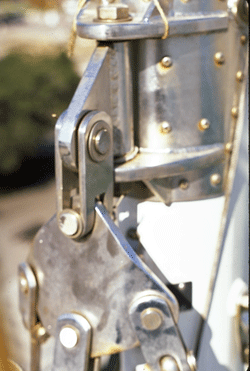
I have seen some solutions where the rotating beak and its base are pushed through the front of the mast. The base is then fastened to the mast. That does reduce the large bolted plate, but I worry that the leverage of the base is so much smaller; like 20 times smaller, that the fastener holes elongate and fail. Also, the rotator base parts must be cantilevered out that much farther. Up top there, every millimeter counts, as I see it.
About the same time, people started building composite chainplates. I decided to try them on composite masts. They worked great and were relatively easy to do and at very low cost. They made especially good sense to do it your selfers.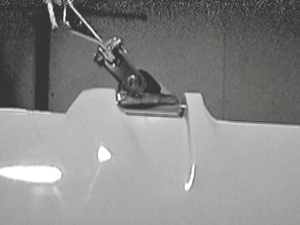
Next I decided to try composite hound bases on aluminum masts. Of course I was worried about the bond between the composite and the aluminum. The technique of an acid wash and alodyne, plus coating the contact area with epoxy and sanding it seems to work. The wet epoxy blocks the oxygen from getting to the aluminum, and the sanding exposes new, unoxidized surface. Additionally, the very large contact area and the wrap-around shape ensure that the composite hound base cannot move.
To solve the problem of three wires coming into a single beak, the Gougeon masts had used a rhomboid stainless steel plate that we called the batwing. Each shroud side of it was bent back to fairlead to that shroud. Again on multis under 40 feet or so, it worked well and lasted a long time. The big boats wore through not the batwing, but the master toggle between the batwing and the rotating beak. I had been insisting on high strength toggles such as Reikman or other 17-5 stainless ones.
A client of mine, Geoff Strange (had a 60’ tri and is building 49’ cat now) came up with a very simple solution. No more batwing. The beak does have to be a bit larger.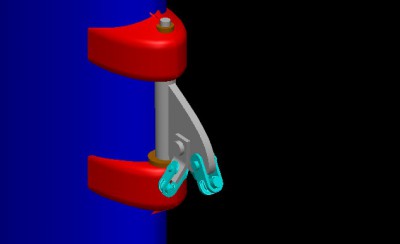
My friend and competitor Roger Hatfield has probably built as many rotating masts as anybody. The last time I talked to him, he had dialed back the rotation on his workboats. He used to use an enormous galvanized shackle up there that all three wires were loosely toggled to. He has since started using three toggles, one for each of the wires, but with loose shrouds. He says he gets only about 30 degrees rotation each way from centerline now, but he feels the simplicity is so much better.
My customers with synthetic rigging do about the same thing as the rigging has more stretch. I could see a time where the forestay line spreads out onto the mast, like in my original imagining, and is epoxied onto the mast; all as one piece.
GF 42 Trimaran
I first saw this trimaran design a couple of weeks ago and had to mull over what I was seeing. My first reaction was it needs a couple of feet of main hull added aft so it trims right in light air.
As I thought about it more, I realized that it was refreshing that he has broken out of the symmetric and “functional” thinking constraints. It is visually appealing. It makes me think maybe I can show some of the weird designs that I have been thinking of.
Back when I went from architecture to naval architecture, the land one was stuck and formulaic. The multihulls were where real innovation was going on, then. Now, except for proas, it seems like multis have become formulaic.
This unit will be heavy and expensive, but he broke out in a great way. He loosened everything up. I like that. I do hope that it doesn’t mean that I have to put Hyundai ridges on everything now. http://www.glyacht.com/
30′ Cat Close to Launch
Another Vid from Simmo
https://www.facebook.com/photo.php?v=10203358114606206&set=vb.1011402351&type=2&theater
“Having fun against two F18 after work in a stormy day (with 1 reef at main)…speed looks pretty close ”
It only lives on Face now, but he thinks he can get a Utubes version soon.
Caiman Trimaran Videos
I found a whole lot of videos of my very early 26′ trimaran design, Caiman, from UK. That tri is significant in at least one way. It was back in the late 80s that someone named Kelsall visited its build site. I was practially unheard of as a designer then. While there, he decided to read my CM construction manual. I was later told that, where in the book I declared that I thought Nick Bailey was the best designer in the world, it enraged him. And didn’t KSS appear shortly after that? I had been doing CM since ’82.
Then later seadog Chris Anderson held ocean racing seminars on Caiman for its new owner. I recall something about an upper coming loose…
https://www.youtube.com/user/888Caiman
These are not Muffalo quality, but interesting.
And if I may, thats a pretty good looking boat for a nearly 30 year old design. The design has been updated, but there wasn’t a lot to improve. Guess I could slap it with a reverse bow stick, but that is more asthetic than anything.
Foil Cats
I realize that most people think that foil bourne catamarans were invented last year. Readers here recall seeing my earlier post of Howard Apollonio’s foiling cat from the 60’s.
And I sailed with Sam Bradfield on his foilers in the early 90s.
Some 8 years ago I was comissioned to design this foiling cat. The hull step was a harder 3D modeling project than I expected. It never got funded. Point is they were not invented last year.
Fasteners
In for just a few minutes to check email and send study plans. Saw this on fasteners. Of course we set most of them in with epoxy. After they get mold release put on them. Because almost all hardware gets changed at some time.
http://www.practical-sailor.com/news/Proper_Fastenings_Dont_Screw_Up-10477-1.html
Hiding Out
Going to hide out for a couple of days so that I can get some CADD drafting done without interruption. Here in office all my time seems to go to answering questions or even reminding people what was agreed to before. No shopping cart until I get back. That too, yes.
Aluminum and Small Multihulls
I always assume everybody knows that aluminum is not optimimal for efficient small multihulls. I assume here that small is under 60′ length. Still, it keeps coming up again. And Bagalut was sweet.
There are many good reasons not to use aluminum for small multihulls. It starts to make sense when the catamarans are over about 50’ length. Smaller than that, it doesn’t make much sense in standard practice multihulls.
Weight
A typical composite 45’ catamaran in foam/glass would have hulls weighing between 1.1 and 1.3 lbs per square foot of hull. Geoff Strange was doing infused hulls that weighed much less than that even.
The same size aluminum cat would likely have 3/16” thick hulls weighing 2.65 lbs per sqft. Because the aluminum hulls are thinner than foam/glass ones, they need much more frequent internal structure than a composite hull. That adds significantly more weight and work again.
Even compared to an epoxy/plywood hull, again the aluminum is much heavier. A 45’ cat in plywood would typically have a 3/8” (10mm) thick hull that will weigh about 1.2 to 1.4 lbs per sqft.
In a recent study by Horsmon, a pair of nearly identical 135’ fast ferries, one in aluminum and the other composite, were compared The composite version had a bare hull weight of 144,000 lbs or 65,454 kg. The aluminum bare hull to the same rule weighed 226,076 lbs or 102,762 kg. The composite hull had only 64% of the weight of the aluminum one.
Thermal Insulation
Aluminum has very poor thermal insulating properties. Of course composite gives very good insulation. In cold climates the air will easily condense on the aluminum hull causing moisture buildup inside. On a hot day, the metal hull can be like an oven.
The interior can be insulated, but that is another step, as below.
Sound Insulation
Aluminum has very poor sound insulation properties. As expected, composite is an excellent sound insulator.
Interior
The interior of an aluminum hull is a much more complicated project than with a composite one. It will need both stringers and frames. Unlike a composite hull where one has usually 6 or 8 feet of smooth surface, the insulation and maybe even the inside surface has to be fitted into the alloy structure. That covering must allow the aluminum to “breathe” so that it doesn’t set up a crevice corrosion situation.
Unfair surfaces
An alloy hull typically distorts by the process of welding it together. Thinner, lighter hulls or those by a less skilled welder will be much more distorted. I understand that the surface of one of my 65’ daycharter cats in aluminum distorted up to a half inch as a result of the welding.
If the cat is to move well under sail or power, it must have fair hulls. To achieve that, the surface hollows must be filled with microbaloons and sanded. That must then be coated and painted. It’s almost like putting a fiberglass hull over the aluminum hull. Typically, aluminum catamarans now are being built by former fish-boat builders. Hull fairness is not even a concept to them still. The solution to getting enough speed for them is to pile on more power, and they do that. Coming from racing catamarans, we know that only a smooth, fair hull can move easily at faster speeds.
Hull Shape
An alloy hull must have a hard chine shape or be rolled into a rounded shape with a huge metal rolling machine. The hard chine is inconsistent with an easily driven displacement multihull. The rolling device is unavailable to many builders.
Fatigue strength
The fatigue resistance of aluminum is not good. After some 5,000,000 use cycles (maybe 10 years), aluminum strength is about 1/5 of what it was in the beginning. Triaxial glass has about ¼ the strength it started with, but it started much higher. Plywood and carbon fiber will have about half the strength they began with, much better resistance to fatigue.
Ultimate strength
According to ABS, the ultimate tensile strength of a 5000 series alloy will be between 31,000 lb and 42,000 lbs. That is the unwelded strength. The welded strength can be much less depending on alloy used.
A typical good backyard glass laminate will be about 60,000 psi in ultimate flexural strength and probably about 50,000 psi in ultimate tensile strength. Plywood will reach between 10,000 and 18,000 depending on species. The strength of aluminum is not as much as that of composite even though it is heavier.
Toxic bottom paint.
Aluminum hulls cannot be painted with the usual copper based antifouling paint. That paint would rapidly corrode the aluminum hull. Instead, either the very expensive and toxic TBTF (tributln tin) bottom paints must be used, or the hull must be primed with an isolation paint first. The TBTF paints are toxic in parts per billion. Here in Washington state, they must be applied by a registered operator. The average owner cannot apply his own TBTF bottom paint. In many areas those paints are being banned.
Lifetime costs
Corrosion is such a concern, that haulouts and inspections must be regular and the paint surface must be perfectly maintained. The lifetime costs will be higher than a composite boat. Randy Rust did part of article on this in an issue of Workboat. I will dig it up for the details.
Ride
Even if they had the same hull shape, the composite hull affords a better ride.
Horsmon notes“The ride quality of the composite vessel will be superior to the aluminum vessel, although they share identical hull forms, because the composite vessel is compliant. The damping effect of the composite panels absorbs many of the short duration accelerations. These same accelerations are transmitted into the primary structure of an aluminum vessel. By the same token, machinery hull borne vibrations are decreased in composite vessels over stiff metallic construction.
Both shocks from hydrodynamic loading, and machinery initiated vibrations should be minimized in marine vessels to provide a comfortable ride to the passengers and prolong the service life of the vessel, as is evidenced in common fatigue studies.”
Conclusion
In conclusion, for multihulls under perhaps 50’ length, an aluminum vessel is not appropriate.
It will be much heavier. Consequently, it will require much larger rig and engine to achieve the same speed as the same vessel in composite.
It will also require a composite structure to be built both outside of it to achieve the necessary fairness and maybe inside to create a livable space.
Over its lifetime it will cost more than the composite vessel.
